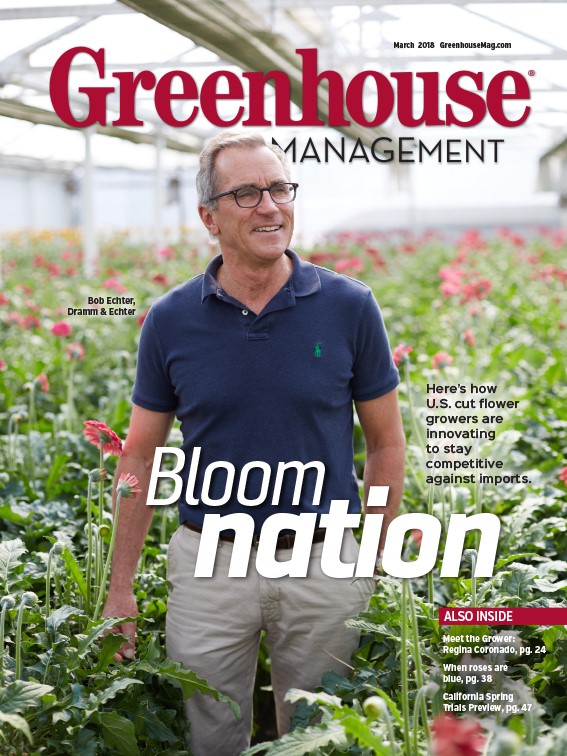
Imagine the scene: It’s Valentine’s Day and you’ve decided to buy a bouquet for your spouse. It’s a last-minute endeavor (isn’t it always?), so you head straight to your local flower shop or florist. As you walk through the door and escape the blustery winter weather that most of the country is facing, you’re greeted by displays of elegant arrangements and colorful bundles of flowers. And that aroma! Much like walking into your greenhouse in full production, you can close your eyes and practically transport yourself to springtime.
But if you then ask for a bouquet of local flowers, you may not have much luck getting it. According to the California Cut Flower Commission (CCFC), a state agency that represents California’s flower farms, about 80 percent of the flowers sold in the U.S. are imported. When it comes to roses, that figure rises to more than 99 percent.
Bob Echter, second-generation owner of California cut flower grower Dramm & Echter, says that the state became a hotspot for carnation growers back in the ’60s, but by the ’80s, the carnation and chrysanthemum markets “were moving to South America.” Not only was labor cheaper, but the temperate climate made for better production. In Ecuador, for example, growers can count on consistent 12-hour days, year-round because of its location on the equator.
These conditions necessitated a shift in U.S. growers’ production, and growers began diversifying into crops that weren’t being imported, such as Gerbera daisies that don’t travel well. In fact, over the years Dramm & Echter has narrowed its offerings to just three crops — spray roses, oriental lilies and Gerbera daisies. While Len Busch Roses, a Minnesotan grower, grows a wider variety of cut flowers, the company only grows 40 percent of what it sells and imports the rest.
However, the “buy local” and “American-made” trends that have surged through seemingly all consumer markets are also impacting the cut flower industry. U.S. growers are banding together to support domestic flower production and promote a “slow flowers” locally grown movement. To learn more about how the U.S. cut flower industry has changed and how it’s looking toward the future, read this month’s cover story.

Karen E. Varga, Editor
216-393-0290 | Twitter: @Karen_GIE

Explore the March 2018 Issue
Check out more from this issue and find you next story to read.
Latest from Greenhouse Management
- Landmark Plastic celebrates 40 years
- CropLife applauds introduction of Miscellaneous Tariff Bill
- Greenhouse 101 starts June 3
- Proven Winners introduces more than 100 new varieties for 2025
- UF/IFAS researchers work to make beer hops a Florida crop
- CIOPORA appoints Micaela Filippo as vice secretary-general
- Passion grows progress
- Registration opens for Darwin Perennials Day





